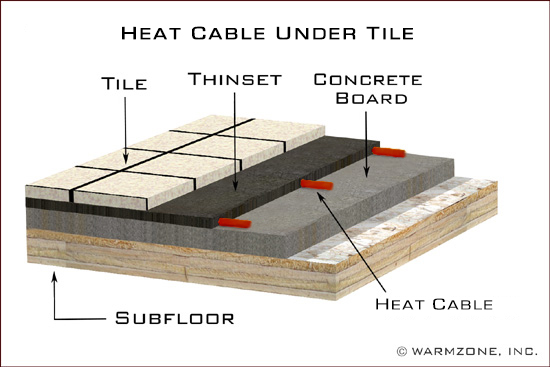

ELECTRIC RADIANT FLOOR HEATING CABLE INSTALL

Radiant Heat Advantages and Disadvantages Compared to Traditional Heating: Radiant heat has advantages compared to traditional heating systems and some disadvantages. Radiant in-floor heating systems heat the sub-flooring and slabs providing heat to the living areas by thermal transfer from the flooring to surrounding structures and space. These two recent installs are the focus of this article.īut first, a bit more about in-floor radiant heating systems. Under the tile, we installed electric radiant in-floor heat using radiant heat cable installed in a channeled decoupling membrane. This summer, I tackled our sunroom, installing all new windows, doors, and floor tile. Last fall, I added the new entry mudroom to our cabin, adding electrical radiant heat mats under the tile install. This is one of the main reasons I added in-floor radiant electric heat to my two newest projects – a small entry mudroom addition and a remodeled attached sunroom. Rooms like additions, mudrooms, porches, sunrooms and garages may be great candidates for in-floor electric radiant heating, especially if adding HVAC ducting or plumbing would be difficult. Electric in-floor heating cable systems are also reasonably priced and essentially maintenance free.Įlectric in-floor heat also solves the problem of adding heat to add-on rooms that would be hard to connect to an existing HVAC system. Electric In-Floor Radiant Heating is Great for the DIY Floor Heating ProjectĮlectric radiant heating systems are relatively DIY floor-reno friendly and are easy to add to floor re-builds or new construction. In general, larger radiant heat systems, especially those used as the primary heating source (like whole-house heating) are water-based (hydronic), while smaller, accessory radiant heat systems make more sense in smaller areas as add-on bonus heating, and as remodeling work.īoth of my recent in-floor radiant heat system installs – a small cabin entry mud room and our cabin sunroom, – used electric radiant heat for the simplicity of installation and efficiency of use as a “add-on” comfort heat source. Water-based radiant heat systems are cheaper to run but require the complexity and cost of plumbing and boilers. Electric radiant heat is more expensive to run, but easier and less expensive to install. Radiant heat system are typically available as electric or water (hydronic) based systems. This article walks through my installation of electric radiant in-floor heat in our recently remodeled sunroom and entry mudroom of our four season cabin in Northern Minnesota. Radiant electric in-floor heat is also fairly easy to install. Radiant in-floor heat provides some of the most comfortable and targeted heating for living spaces when installed and operated correctly.
ELECTRIC RADIANT FLOOR HEATING CABLE UPGRADE
Radiant in-floor heat systems are a fantastic upgrade to any tile floor.


 0 kommentar(er)
0 kommentar(er)
